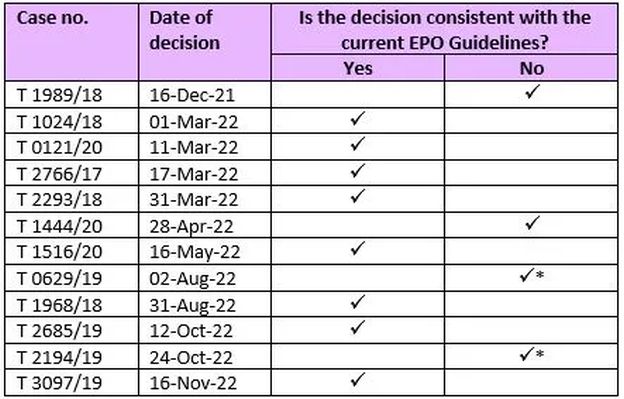Many readers will be all too familiar with the EPO's somewhat draconian approach in relation to description amendments. For the uninitiated, an update to the EPO's Guidelines for Examination in March 2021 precipitated a significant change in EPO practice in cases where there are perceived inconsistencies or contradictions between the claims and the description, which typically result from the claims having been amended during prosecution. In such cases, the Guidelines now require the description to be amended to address any such issues prior to grant, which can potentially involve quite extensive changes to the description. This quirk of EPO practice is sometimes referred to as "adaptation of the description" or the "description amendment requirement".
As an example, if claim 1 originally defined an apparatus comprising features A+B, and was then amended during prosecution to claim feature C in combination with A and B (i.e. A+B+C), then the current EPO Guidelines say that the description must be amended to remove any suggestions that feature C might be optional. For instance, statements along the lines of "in some embodiments, the apparatus may comprise C" should either be deleted entirely or amended to simply state "the apparatus comprises C". However, it is not uncommon for more extensive changes to be needed to satisfy the EPO examiner, particularly when the amended claims now exclude large parts of the original description or drawings.
Many people take the view that such amendments are unnecessary, unduly burdensome, and potentially increase the risk of a granted patent being revoked on grounds of added matter. Others, notably of course the EPO, would argue that such amendments are not only necessary to comply with the requirements of the European Patent Convention (EPC), but also help to increase legal certainty for third parties by removing statements that might otherwise cast doubt on the intended scope of protection. However, it is noteworthy that no other major patent offices insist on the description being adapted to conform to the amended claims, certainly not to the extent that is currently required by the EPO.
Unsurprisingly, the updates to the Guidelines in 2021 and subsequent tightening of EPO practice has prompted much debate within the European profession. Notably, the Boards of Appeal of the EPO have issued conflicting decisions on this subject since March 2021, raising serious doubts over whether there is in fact any legal basis for the EPO's current practice.
The divergent case law from the EPO Boards of Appeal is illustrated in the following table, which lists in chronological order those decisions that have directly addressed, at least to some extent, the question of whether there is legal basis for the EPO's current practice as enshrined in the Guidelines:

* denotes cases in which it was held that adaptation of the description may sometimes be necessary, but where the decisions seem to contradict the current EPO Guidelines over the extent of amendment that should be required
Against this backdrop of increasingly divergent case law, one Board of Appeal has recently proposed to refer a question to the Enlarged Board of Appeal (EBA) on the matter of legal basis for the description amendment requirement. Specifically, in a communication dated 21 July 2023 on pending appeal T 0056/21, the Board proposed referring a question to the Enlarged Board on whether a claim could be found to lack clarity or support under Article 84 EPC if "a part of the disclosure of the invention in the description and/or drawings... is not encompassed by the subject-matter for which protection is sought". The Board also invited the appellant, Roche, to comment on the proposed referral.
In submissions filed on 30 October 2023, Roche proposed the splitting the question into two parts, as well as modifying the wording of the first question slightly to cover both opposition and examination proceedings (replacing "an application" with "the specification"), and to refer to the claims as a whole rather than just to "a claim" in the singular. Roche's version of the question(s) is as follows, with changes indicated relative to the Board's original proposal:
- Is there a lack of clarity of the claims or a lack of support of the claims by the description within the meaning of Article 84 EPC if a part of the disclosure of the invention in the description and/or drawings of the specification (e.g. an embodiment of the invention, an example or a claim-like clause) is not encompassed by the subject-matter for which protection is sought as defined in the claims ("inconsistency in scope between the description and/or drawings and the claims")?
- If the answer to question 1 is "yes", can an application consequently be refused based on Article 84 EPC if the applicant does not remove the inconsistency in scope between the description and/or drawings and the claims by way of amendment of the description ("adaptation of the description")?
As acknowledged by Roche in their submissions, question 2 may actually be redundant, since if the EBA answers "yes" to question 1 then it could be expected that the answer to question 2 would inevitably also be "yes".
In a further development, two sets of third-party observations (TPOs) were filed anonymously on 24 November 2023. The TPOs cite several articles published in the official journals of the European Patent Institute, EPI, (epi information) and of the Chartered Institute of Patent Attorneys (the CIPA journal). The articles cited in the TPOs all appear to support the Board's view that the recent case law is divided over the description amendment requirement, as well as drawing attention more generally to the negative consequences of the EPO's current draconian approach. It therefore seems that whoever filed the TPOs, did so with the aim of giving the present Board further encouragement to press ahead with a referral.
Given that the Board, Roche, and the anonymous author(s) of the TPOs all seem to be in favour of a referral to the EBA, it would be surprising if the Board does not go ahead with a referral. Following a referral, and assuming that the EBA finds the referral to be admissible, it is likely to be at least another year or two before the EBA issues a decision (e.g. late 2025, or early 2026). Hence, whilst there may now be a light at the end of the tunnel, it is admittedly somewhat distant. Nevertheless, the mere possibility of a referral to the EBA will undoubtedly come as welcome news to professional representatives and applicants alike, since an EBA decision should ultimately result in greater legal certainty for all parties. We will of course keep a close eye on the progress of T 0056/21, and will report any further developments as and when they arise.
The content of this article is intended to provide a general guide to the subject matter. Specialist advice should be sought about your specific circumstances.
